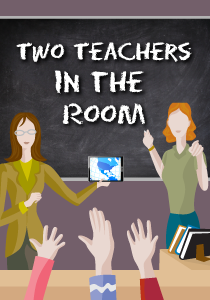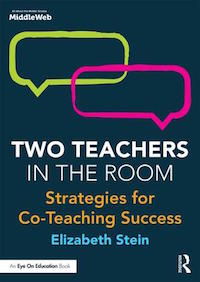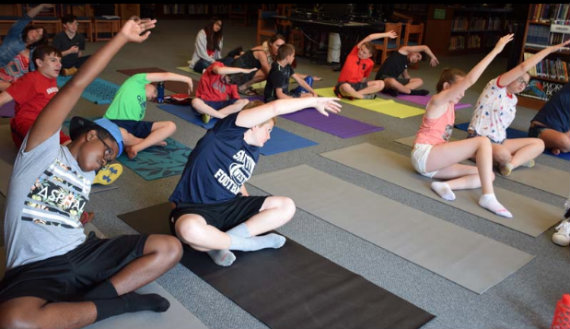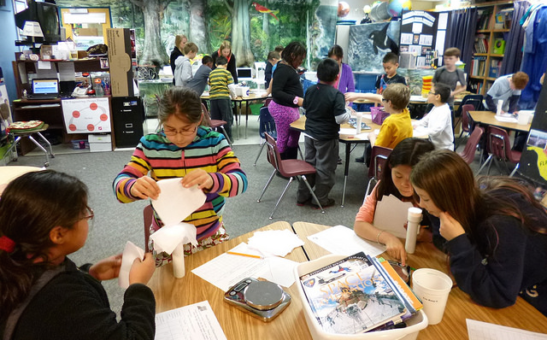Use Visible Thinking to Power Up Co-Teaching
A MiddleWeb Blog

Before we begin this week’s post, I’d like to thank the educators who contributed to our summer collaborations at Two Teachers in the Room. I enjoyed staying connected in thinking about how we can apply our experiences to continuously improve our co-teaching practices. If you’d like to read what was shared, check out the comments at this post (and feel free to share your voice to continue the conversation!).
This summer I had a variety of experiences that kept me balanced, grounded, and ready to forge ahead on a mission to create equitable and meaningful inclusive, co-taught experiences. During the month of July, I coordinated a summer program to empower middle school students to strengthen academic, social and emotional skills.
This program (in its 4th year) focuses on incorporating a potent mix of growth mindset, universal design for learning, genius hour, and social emotional learning with students who for unknown reasons are not meeting their potential during the school year. Check out my post at Education Week, How to Take a Growth Mindset Approach into Summer Learning, for a bit more detail.
So here I am now…on a quest to take our summer learning into the school year. And I wonder…how can teachers weave in effective practices that value the strengths and needs of each learner, while making them feel like an important part of the learning in any classroom?
Ask the Students
One of my greatest takeaways from the summer program is always the same: Listen to the students. There is so much to learn from making the time to just ask students to share their thoughts and experiences.
One question I asked a group of around 20 students (grades 7-9) was this: “Visualize any of your classes (co-taught or not). How did you feel during the learning process?” A high percentage of these students responded: “Left out, sad, anxious, embarrassed, worried, uncomfortable, don’t belong, confused, and invisible.”
Of course this is painfully difficult to hear. But oh, what we can now DO as a result of knowing this is how some students feel. Before you say to yourself, not in my class or not my students, reflect on the culture of learning and thinking that a visitor might witness in your classroom.
Do you make sure that each student in your class feels included and valued? What does the process of learning look like on any given day? Is your classroom a safe space for EACH student to feel comfortable to think, share thoughts, and personally connect and participate in meaningful ways?
A Thinking Classroom Culture
How is a thinking classroom culture created, and how much control does the teacher have in this creation? No need to think too long on that one…let’s just meet the fact straight on! The teachers in the room play a critical role in the culture and learning environment that is established and lived every day.

Using the framework, it’s possible to create a visible representation of what a learner is thinking. How great is that?! Students engage, participate, and feel valued as the seemingly intangible act of “thinking” becomes visible to themselves and to others. Voila! You’ve achieved that learning community environment that teachers strive to create.
Take five minutes to grasp the core ideas behind the Visible Thinking framework:
Creating a classroom culture of thinking that is visible can be just the thing to change those negative student responses I shared earlier into positives. For example, any student who feels confused or embarrassed will now feel clear-minded and accepted—simply because the teachers decide to make sure that all thinking is valued and appreciated. Anxiety can be redirected into curiosity as students actively seek knowledge and collaborate with teachers and peers.
OK…so how can YOU take those first steps toward creating a culture of thinking in your classroom this year?
First Steps
- Value and accept all thinking. Each learner (including each teacher) has strengths that connect learners, in the moment, with the content and context of learning.
- As you plan your lessons, raise your awareness about the opportunities for everyone to think…and think deeply. Co-teachers are at an advantage here—two viewpoints are better than one!
 Next Steps
Next Steps
Explore these core thinking routines for some quick and deep ways to value and embrace everyone’s thinking. Three of my favorite go-to strategies are Circle of Viewpoints, See, Think, Wonder, and I Used to Think…Now I Think… Oh! and I can’t forget to include Compass Points. OK, OK, you caught me…I love them all!

No student (or co-teacher!) should EVER feel invisible…so please think about how you will apply strategies to include all thinkers this year in your classroom. Begin here—take a moment to make your thinking visible by sharing your thoughts in the comments section below.
Here’s to a positively impactful school year to all!
________________________
* For more information on structures for thinking, see Katrina Schwartz’ article, When Kids Have Structure for Thinking, Better Learning Emerges, at KQED’s MindShift.
Feature image: PZ Thinking Routines by Sue Borchardt

































Dear Elizabeth Stein, I am excited about what you have shared, Creating a Thinking classroom Culture. I am head teacher of a High school with 32 years of teaching experience. What you have shared is true and can be achieved. I have in my current school learners who are obsessed with negative thoughts like worries, low self-esteem, feelings of inadequacy and so on. I have devised a program very much like yours. Every morning before first lesson I ask them to write a short story of their positive experiences that day, and likewise, before leaving school in the afternoon. This, hopefully would drift their thoughts from negativity to positivity, enabling them to learn. Positive thoughts are very powerful and can enhance learning. I have begun seeing good outcome of learning as a result of the program. Thank you.
Grateful to have stumbled upon this article. It has reignited thoughts. Last year I used the I See, Think, Wonder strategy. As I plan, I need to remember to dust off the tools in my toolbox that were effective with students.